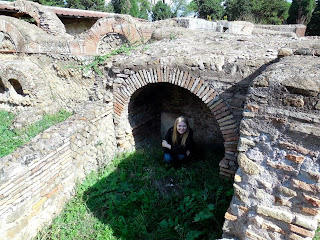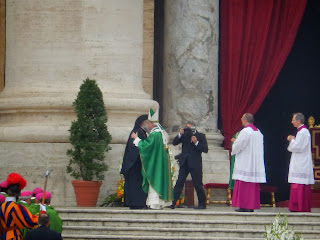On Sunday, October 6, I took a train to Assisi with a large group of Saint Mary's girls for our first independent, out-of-Rome trip. It was a beautiful sunny day, and what I noticed first as we stepped of the train that morning was just how quiet and peaceful it was compared to Rome! Assisi is two hours northeast of Rome by train, deep in the agrarian region of Umbria (nicknamed Umbria verde for its excellent farmland and delicious products). There are lots of small mountains (or large hills?), and Assisi is situated on top of one of them, largely the same as it has been for a thousand years. We walked from the train station - at the bottom of the valley - to nearly the top of the city, which was quite a hike. Pope Francis had been there just two days earlier, celebrating the feast of Saint Francis of Assisi, and there were still lots of banners, balloons, podiums, Vatican flags, and signs left over from the event.
Vatican flags making a cameo
Umbria in the background
Church of Saint Francis
We enjoyed a beautiful (and surprisingly modern) Mass in the ornate Church of Saint Francis, with a gorgeous view of the Umbrian plains around us, before enjoying a relaxing afternoon of wandering through the medieval streets, shopping for souvenirs and finding lots of little historical treasures (including the body of Saint Clare, one of Francis' closest friends, and the remains of Francis' father's house).
The next weekend, on Saturday the 12th, I went with four friends to Ostia, a gorgeous set of ruins in one of Rome's most important early cities. Established as Rome's first "colony," it sits at the mouth of the Tiber as it flows into the Tyrrhenian Sea. It's a short train ride west from Rome, and again we had perfect weather as we explored the ancient city. Unlike the ruins at the Roman Forum and other places within Rome, you can actually touch, climb, and engage with the buildings in Ostia, which for me was a boatload of fun. We ate our lunch in the actual amphitheater the Ostians used and saw the beautiful mosaics on the floor of their baths, still preserved even in the open air. The trip was made even more enjoyable when we took the wrong bus not once but twice, thereby getting an accidental grand tour of Rome before and after our Ostia adventure; I say this totally without sarcasm, because it was a real pleasure to see parts of the city I hadn't seen before.
Old tomb at the Ostia necropolis!
Gorgeous floor mosaics still preserved at Baths of Neptune, Ostia
Freestanding ancient statue without a head!
Just this past weekend we got on an early bus as a full group to tour Tarquinia and Cerveteri (formerly known as Caere) to see several Etruscan tombs, which we've been studying ad nauseam in my archaeology class and the art history course. (I'm complaining in jest; it was actual very, very neat to see these tombs in person after studying them for so long.) The Etruscan civilization was gradually overcome by Romanization, but it was a powerful presence in Italy for many centuries before Christ and heavily influenced the later Roman culture with its art, its customs, and its architecture. However, since most Etruscan buildings have been lost over the thousands of years, almost all that remains of them is found in the subterranean tombs they left behind, especially those at Tarquinia and Cerveteri. Tarquinia is home to dozens of painted tombs belonging to wealthy families who could pay for elaborate, colorful scenes on the walls of tombs; Cerveteri's elite instead constructed massive rock-cut tombs (not built, but actually carved out of bedrock) in a giant necropolis eerily similar to the living city nearby. Like Ostia, we could actually go inside the Cerveteri tombs, which was simultaneously haunting and fascinating. For lunch we had a picnic on the shores of the chilly Tyrrhenian, enjoying some much-needed quiet and fresh air.
Tyrrhenian Sea with lovely friends
Painted tomb at Tarquinia
Rock-cut tomb at Cerveteri
Meanwhile in Rome, I've been continuing to adapt and explore and learn on a daily basis (which is both exhilarating and exhausting)! Last Wednesday a few friends and I took an after-dinner passeggiata to the Vatican and ended up chatting with two young Swiss Guards who were outside. (Pope Francis' personal secretary also walked past, which was quietly incredible.) They told us about their duties and their life in Rome and what it took to be a Swiss Guard (Swiss, male, Catholic, and of a certain age). That was definitely an "only-in-Rome" experience, and one of which I hope to have many more.
Another O-i-R experience was commemorating the 70th anniversary of the deportation of the Roman Jewish community at the Jewish Ghetto on the evening of October 15. I enjoyed a delicious Roman Jewish meal (fried artichoke, cod, zucchini flowers stuffed with grouper, and a fruitcake-like dessert that I devoured) and then joined a procession through the streets of the Ghetto with hundreds of Jewish Romans. As we walked, a man spoke the names of every deported citizen (of which there were over a thousand), including a painfully long list of children. What struck me most of all was that as the names were read, there would be sometimes over a dozen of a single last name: entire families, completely wiped out. Just before the end, we paused for a while in front of a slideshow of the photographs of all the deported, of which only sixteen returned. It was a very humbling experience, especially as a non-Jew, and I'm glad I could participate.
One of these days I PROMISE I'll have a post about food. It's worth a blog post, that's for sure.






















































